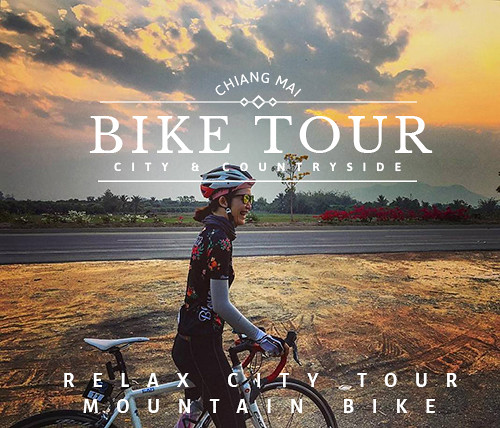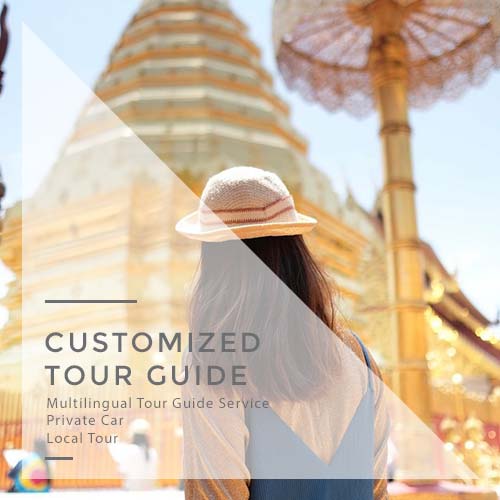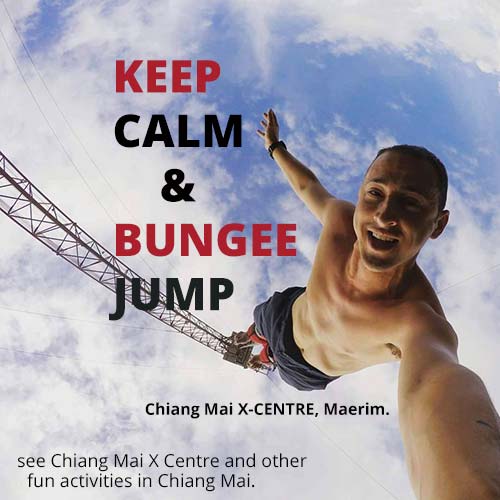

- Wat Phra That Doi Suthep is the most important temple in Northern Thailand. For centuries, it has been a spiritual center, attracting both devout pilgrims and tourists from around the world.
- Perched atop a mountain, this 14th century temple offers breathtaking panoramic views of Chiang Mai.
- Whether you prefer the freedom of planning your own itinerary, or the convenience of joining a guided tour, this comprehensive guide will cover everything you need to know for an unforgettable trip.
High atop Doi Suthep mountain, overlooking the city of Chiang Mai, sits Wat Phra That Doi Suthep, a majestic temple revered by many.
Wat Phra That Doi Suthep holds a place of immense significance in the hearts of Chiang Mai’s people. For centuries, it has been a spiritual center, attracting both devout pilgrims and curious visitors from around the world.
There’s a popular saying among the locals: a trip to Chiang Mai isn’t complete without visiting Wat Phra That Doi Suthep. It’s not just its religious importance that draws visitors; Wat Phra That Doi Suthep offers a captivating combination of historical significance, cultural immersion, and stunning panoramic views.

This magnificent Buddhist temple, adorned with shimmering gold, is not just a place of worship, but the holiest site in all of northern Thailand.

Wat Phra That Doi Suthep’s beauty goes beyond its structures. The temple complex offers stunning views of Chiang Mai that will leave you breathless.
The temple complex is a testament to the incredible skill and artistry of its creators. Every element, from the architecture to the statues, murals, and shrines, is imbued with a sense of awe-inspiring beauty.
At an elevation of over 1,000 meters (3,500 feet), Wat Phra That Doi Suthep commands a breathtaking panoramic view of Chiang Mai.
Often simply called Doi Suthep itself (though this refers to the mountain), the majestic temple is located nearly 15 kilometers outside of Chiang Mai city center. The drive takes only about 25 minutes, making it a popular destination for both locals and tourists.

Wat Phra That Doi Suthep holds deep significance for Buddhists, drawing pilgrims and witnessing even larger crowds during major holidays like Visakha Bucha and Makha Bucha.

Gazing out at the city from the mountaintop can be a calming and reflective experience, especially for those seeking spiritual solace.
The History of Wat Phra That Doi Suthep
Wat Phra That Doi Suthep, constructed in the late 14th century under King Keu Naone’s reign, is a functioning Buddhist monastery with a rich history. Established in 1383, the temple’s origin story centers around a sacred relic – a bone fragment believed to be from the Buddha’s shoulder.
Legend tells of a wandering monk from Sukhothai who brought the bone shard to the Lanna kingdom. As the story goes, the shard broke into two pieces at the foot of Doi Suthep mountain. One piece found its home at Wat Suan Dok, while the other embarked on a more mystical journey.
Placed upon a white elephant, a revered symbol in Thailand, the fragment was released into the jungle. The elephant, guided by an unseen hand, climbed the western slope of Doi Suthep. After reaching a specific location, the elephant trumpeted three times before collapsing.
This event was interpreted as a divine sign, prompting King Keu Naone to order the construction of a temple on that very spot. Today, the pagoda enshrines the holy relic, a testament to the enduring legacy of this sacred place.
What To See at Wat Phra That Doi Suthep
Upon arrival, visitors have a choice: take a funicular railway directly to the summit, or climb the 306-step Naga Staircase, flanked by statues of nagas (serpent deities).
The naga-guarded steps, though seemingly challenging at first, are adorned with beautiful foliage and offer a unique experience. Each step is lined with statues of nagas, serpent-like guardians from mythology, creating a visually stunning and culturally significant path.
Reaching the top is a rewarding experience. Golden pagodas, shrines, bells, and statues unfolds before you. The most sacred structure is the golden chedi, which enshrines holy Buddha relics.
The temple grounds offer many areas for visitors to pay their respects, kneel in prayer, and even receive blessings with offerings and incense. Elder monks are present in two public prayer rooms, ready to offer blessings to those who seek them.

The journey to the temple begins with a climb up the 300 steps of the Naga Serpent Staircase. However, for those who prefer a more leisurely ascent, a funicular cable car is available to whisk you effortlessly to the summit.

At the foot of the staircase you’ll find several souvenir shops, vendors selling local handicrafts, and some food stalls where you can grab a bite after visiting the temple.

At the very top, you’ll be greeted by a breathtaking sight. The entire scene is a powerful testament to the faith and devotion that inspired its creation.
Venture beyond the central area and you’ll discover the shrine dedicated to the White Elephant, accompanied by a story etched on the wall that explains the temple’s origins.
A wide walkway encircles the main temple, leading to a breathtaking viewing terrace. This panoramic viewpoint offers unparalleled, sprawling views of Chiang Mai, making it a favorite spot within the complex.
Right next to the viewing terrace, you’ll find one of the world’s largest gongs. Feel free to strike it and experience its deep, resonating sound.
For those interested in history, a museum within the temple grounds houses ancient relics, photographs, and artifacts related to the temple. The complex also includes living quarters for monks, a prayer hall (Ubosot), a souvenir shop, and small shops selling drinks and snacks.

Towering statues stand as silent guardians, and a golden chedi, one of the temple’s most sacred structures, enshrines holy relics of the Buddha himself.

The temple grounds are adorned with a collection of small bells. Legend has it that visitors who strike each bell in sequence will be blessed with good fortune.

The view deck offers a fantastic opportunity to admire Chiang Mai’s panoramic view. On a clear day, the view stretches for miles, allowing you to see far into the distance.
How Much Does It Costs to visit Wat Phra That Doi Suthep
The entrance fee to visit Wat Phra That Doi Suthep is very affordable, costing only 30 Baht. If you are feeling energetic, you can walk up the stairs to reach the temple grounds. There are 306 stairs, so it can be a bit of a climb, but it’s free!
Alternatively, if you prefer a more relaxing option, you can take the funicular railway directly to the top. This convenient ride costs an additional 20 Baht on top of the entrance fee.

You can skip the stairs to reach the temple ground by taking the funicular railway all the way to the summit. Ticket costs 20 Baht.
How To Go to Wat Phra That Doi Suthep
Wat Phra That Doi Suthep is situated approximately 15 kilometers from the center of Chiang Mai. There are several ways to reach it from the city.
The cheapest option is taking the shared songthaews, while taxis offer a faster, comfortable ride. Adventurous travelers can rent a car or motorbike for the scenic climb (be prepared for mountain roads). Guided tours provide transportation, insightful explanations, and often include visits to nearby temples.

A red songthaew like this one is a very common type of public transport in Chiang Mai. It’s also the cheapest option to get to Wat Phra That Doi Suthep.
Songthaew – The Public Transport to Wat Phra That Doi Suthep
Taking the songthaew is the cheapest way to reach Wat Phra That Doi Suthep from Chiang Mai city. These red trucks are the city’s most common form of public transportation.
To get to the songthaews heading towards Wat Phra That Doi Suthep, you’ve to go to the designated area in front of Chiang Mai Zoo. You can easily reach the zoo itself by catching another songthaew from anywhere in Chiang Mai for a fare around 40 Baht.
Once at the zoo, you’ll find songthaews waiting for passengers. A one-way trip to Wat Phra That Doi Suthep from here also costs around 40 Baht. However, the driver will wait to fill the songthaew with 10 people before departing. This waiting time can sometimes reach an hour.
If you’re short on time, you can negotiate with the driver for a quicker departure by paying a higher fare.

Red songthaew going up to Wat Phra That Doi Suthep readily waiting for passengers at the designated area near Chiang Mai Zoo.
Another option is to hail a songthaew anywhere in the city and charter it directly to Wat Phra That Doi Suthep.
This will be more expensive, costing at least 300-400 Baht one way. Since drivers might not want to return empty-handed, they might ask for a fare for a return trip as well, bringing the total cost to around 800 Baht.
However, if you’re traveling in a group of up to 10 people, this can be a cost-effective option as you can share the fare.
Take a Taxi / Grab to Wat Phra That Doi Suthep
If you’re not worried about cost, then a taxi or Grab ride directly to Wat Phra That Doi Suthep from Chiang Mai is a convenient option. It’s also the fastest and most comfortable way to get there. You can expect to pay around 400 Baht each way during off-peak hours.
However, it’s important to be aware that not all taxi drivers are willing to make the trip up Doi Suthep. You might need to ask a few drivers before finding one who is available. Some drivers might accept your ride request, but only if you pay for the return trip as well. This is because they don’t want to drive back down the mountain empty. They might be willing to wait for you at the temple and drive you back to the city once you’re finished exploring.
In this situation, especially if you’re traveling alone, it might not be the most economical choice. Because there are tour companies in Chiang Mai that offer half-day temple tours for less than the cost of a round-trip taxi fare, using a very comfortable air-conditioned van.

In non-peak hours, the Taxi / GRAB fare going to Wat Phra That Doi Suthep from Chiang Mai city is around 400 Baht.
Self-Driving to Wat Phra That Doi Suthep
You can rent a car and drive yourself to Wat Phra That Doi Suthep. This is the best option if you prefer to explore at your own pace and create your own schedule.
The temple is conveniently located just 15 kilometers from Chiang Mai city, and the route has minimal intersections. Navigating with Google Maps is a breeze, thanks to the straightforward route.
Keep in mind that the road is windy as it climbs the mountain. There might be a few steeper sections to navigate cautiously. Parking is no problem at the temple, with clear English signage to guide you. Expect to pay around 100 Baht for parking.

The route from Chiang Mai city to Wat Phra That Doi Suthep can be easily navigated using Google Map. Just be careful with the windy road as it climbs the mountain.
Renting a car is very easy as there are many car rental companies in Chiang Mai, offering options for all budgets. Prices typically start around 700 Baht and can go up to 1500 Baht per day, depending on the car’s size and features.
For your convenience, many rental companies are located right at Chiang Mai Airport so you can pick up your car easily upon arrival.
Alternatively, you can also choose and book a car online here and have it delivered to your hotel. Most car rentals include comprehensive insurance that covers the driver, passengers, and the vehicle in case of an accident. (check your date & availability here)
For your trip to Wat Phra That Doi Suthep, a four-wheel drive is not necessary; a standard sedan has sufficient power to reach the summit.
Half-Day Tour – Join Tour with Guide
For those who find taking a shared songthaew to Wat Phra That Doi Suthep inconvenient, joining a temple tour is a great option then. The tour price is even cheaper than a round-trip taxi or chartered songthaew fare to Doi Suthep. Plus, these tours often include visits to other temples, making your experience richer.
Chiang Mai is known for its many beautiful ancient temples. If you’re interested in visiting them, there are many tour companies offering half-day or full-day tours. A standard morning/afternoon half-day tour costs around 600-700 Baht only. (check your date & availability here)
Normally, the tours use comfortable air-conditioned van to pick you up from your hotel. An exciting feature is the option to choose between a sunrise or sunset tour. Each offers a unique atmosphere.
Sunrise Tour to Wat Phra That Doi Suthep
The sunrise tour allows you to witness and even participate in the morning alms giving ceremony to the monks. You’ll be at the temple with the first light of dawn, enjoying the breathtaking view of the sunrise from the viewpoint. This early visit also lets you experience the temple before the crowds arrive. (check your date & availability here)
Night Tour to Wat Phra That Doi Suthep
For some, the night tour to Wat Phra That Doi Suthep might be even more appealing. Besides offering a beautiful mountain sunset, the night brings a peaceful and serene atmosphere to the temple grounds with fewer tourists around.
The cool evening breeze makes exploring Doi Suthep even more enjoyable. You’ll see the golden statues and temples shimmer under the moonlight.
On the way back to your hotel, the guide might stop at a viewpoint halfway down the mountain, allowing you to admire the city of Chiang Mai sparkling below. (check your date & availability here)

The best time to visit Wat Phra That Doi Suthep is actually at night. With fewer tourists around, you can soak in the temple’s serenity and appreciate the intricate details illuminated by the moon’s glow.

Night tours often include a stop at a viewpoint halfway down the mountain, offering a breathtaking panorama of Chiang Mai illuminated against the night sky.
Full Day Tour to Various Ancient Temples in Chiang Mai
Many tours to Wat Phra That Doi Suthep are half-day adventures, often combined with a visit to another historical gem, like Wat Umong and Wat Pha Lat.
However, for those seeking a more immersive experience, full-day tours are available. These tours delve deeper into Chiang Mai’s rich history by including visits to several centuries-old temples within the Old City walls. This itinerary is a perfect example of such a comprehensive exploration. (check your date & availability here)
The Viewpoint at Halfway to Wat Phra That Doi Suthep
One of the perks of joining a tour to Wat Phra That Doi Suthep is the chance to stop at a scenic viewpoint along the way. This stop offers a stunning panoramic view of Chiang Mai sprawled out below.
If you visit Chiang Mai during the rainy season, you might even be lucky enough to witness a breathtaking sea of clouds blanketing the city.

On your way up Doi Suthep mountain, during a tour to Wat Phra That Doi Suthep, your guide might take a break at a scenic viewpoint called Chaloem Phra Kiat Pavilion.

On a clear day, the view stretches for miles, allowing you to see far into the distance.

You might even catch a glimpse of airplanes landing or taking off from the nearby Chiang Mai International Airport.

For a truly magical experience, visit during the rainy season when you might be lucky enough to witness a sea of clouds blanketing the landscape.
The Best Time To Visit Wat Phra That Doi Suthep
Wat Phra That Doi Suthep is opened every day from 6.00am to 8.00pm. If you’re using public transportation to reach the temple, it’s wise to plan your departure before sunset so that you can catch a songthaew back to Chiang Mai.
However, for an experience unlike any other, I highly recommend visiting Wat Phra That Doi Suthep at night. Not only does this avoid the daytime heat, but it also allows you to appreciate the temple in a completely new light. The golden statues and temples of the temple complex itself take on a magical glow under the soft moonlight, creating a breathtaking scene.
But the magic doesn’t stop there. From the view deck, witnessing the city slowly transform from daylight to a glittering tapestry of city lights is an unforgettable experience. You’ll see Chiang Mai come alive in a whole new way.
Some Tips & Talking Points When You Visit Wat Phra That Doi Suthep
When visiting Wat Phra That Doi Suthep, visitors should dress modestly. This means wearing shirts or blouses with sleeves that cover your shoulders, and long pants or skirts that go down below the knee. Shoes will need to be taken off before entering any temple buildings. If you don’t have clothing that meets this description, there are sarongs available to rent at the entrance.
While Wat Phra That Doi Suthep sits atop a mountain, accessibility shouldn’t prevent you from experiencing this stunning temple. The entire complex is designed to be wheelchair friendly, ensuring everyone can enjoy its beauty and cultural significance.
Doi Suthep Vipassana Meditation Center, also known as the International Buddhist Center, conducts a variety of religious outreach programs for visitors. Courses are individual and can last up to three weeks for beginners. Visit their website fivethousandyears.org for more information.
If you’re driving by yourself to Wat Phra That Doi Suthep, consider continuing 6km further up Doi Suthep to Bhubing Palace, the Thai royal family’s charming winter residence. Built with teak, the complex offers a main pavilion, a fern garden, a royal princess’s log cabin, and a two-story guest house. Lush gardens bursting with flowers, especially roses, surround the buildings. Well-maintained and peaceful, the site has signs explaining each building’s purpose. Allow 1.5 hours to explore.
When you have finished visiting Wat Phra That Doi Suthep, ask your driver or guide to drop you at Malin Plaza on the way back to Chiang Mai. This lively night market is a hidden gem, popular with locals and conveniently located near the foot of Doi Suthep mountain. Unlike the more tourist-filled markets, Malin Plaza remains a favorite among locals, offering a more authentic experience.

Visitors to the temple may see cats and dogs around. Some may be big, but relax, they’re used to visitors and likely won’t bother you.





















